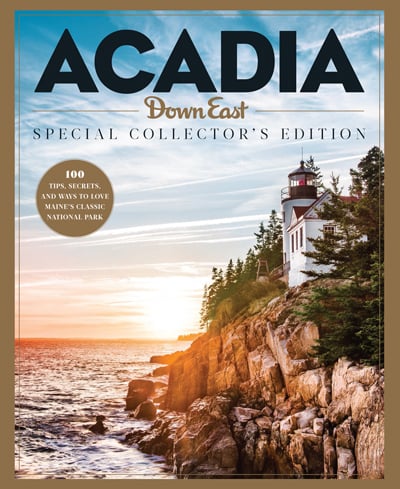By Jill Tompkins
Illustration by Christine Mitchel Adams
From our June 2016 issue
Some 15 years ago, on one of my family’s traditional summer journeys from Indian Island to Acadia, I stood at the summit of what’s now called Cadillac Mountain, overhearing a park ranger giving a tour. She said to her group something like, “The Indians of this area were called the Wabanaki,” and went on referring to Maine’s indigenous people in the past tense — as if they were extinct. Only my reluctance to cause the ranger embarrassment kept me from tapping her on the shoulder and announcing, “We Wabanaki are still here!”

Cadillac Mountain is the first place in North America to see the sun rise (at least at certain times of year). Wabanaki people, particularly the Penobscot Nation and the Passamaquoddy Tribe, have lived on MDI and the surrounding seacoast for more than 10,000 years. The word “Wabanaki” derives from the Algonquian words waban (“light” or “white,” referring to dawn) and aki (“land”): dawnland. Because the island is visible from so far off, the Wabanaki’s early ancestors, known as the Etchemin, called it Pemetic, translated as a “range of mountains” or “mountains seen at a distance.”
At the time of contact with the French in the late 1600s, the island’s Etchemin village headman or chief was named Asticou. The word means “kettle,” and the Wabanaki used it to describe stone basins formed by water plunging continuously against rock. Such geological formations are attributed to the playful megalandscaper and culture hero Glooskap, a giant whose adventures helped shape the landscape, including the mountains and stone cliffs of MDI. Despite the presence of the indigenous Wabanaki, the French government granted rights to Mount Desert Island to the adventurer Antoine de la Mothe de Cadillac in 1688.
Since time immemorial, Wabanaki people have migrated between inland and the coast, responding to the rhythm of the seasons. Traditional coastal encampments are found throughout present-day Acadia, including sites at Manchester Point (Northeast Harbor) near the mouth of Somes Sound, at Bar Harbor and Hull’s Cove, and on neighboring islands like Great Cranberry. Bar Harbor was, and still is, a beloved site for collecting shellfish, particularly the clams that previous generations of Wabanaki would bake or dry by smoke. Even after colonization and the arrival of the rusticators, Wabanaki people continued to make seasonal trips to the area. In the late 1800s, they turned to traditional arts as a means of survival, setting up a village along Bar Harbor’s north shore, where they sold their handiwork. “Fancy baskets” made of brown ash and saltwater-grown sweetgrass appealed to Victorian tastes.
In 1790, a century after Cadillac was granted rights to the island, the U.S. Congress barred states from forming treaties with the tribes or buying or selling Indian lands without Congressional approval. The Commonwealth of Massachusetts ignored the law, however, and subsequently entered into treaties with by-then-impoverished Passamaquoddy and Penobscot tribes, who ceded almost all their ancestral territory and were promised an annual stipend and provisions like food, clothing, and blankets. In 1972, the Passamaquoddy Tribe — later joined by the Penobscot Nation and the Houlton Band of Maliseets — filed a lawsuit against the U.S. Department of the Interior, claiming the land transfers were illegal since Congress never approved the treaties. The tribes’ claim sought the return of more than two-thirds of the state of Maine, including the land that comprises Acadia. The suit was settled in 1980 for $81.5 million, much of which the tribes used to buy back lands across the state.
A couple of years after I overheard that park ranger, Aroostook Band of Micmacs Chief William Phillips contacted park headquarters after a family outing on MDI, expressing dismay that park signage and literature essentially ignored the Wabanaki’s ancestral presence. His concerns led to a meeting between park staff and Wabanaki community leaders and, eventually, to a landmark ethnography called Asticou’s Island Domain, a joint project of the park service and Bar Harbor’s Wabanaki-focused Abbe Museum. The work was the beginning of an ongoing dialogue between the park service and the Wabanaki tribes, to ensure our voice is heard throughout the park.
Last December, after more than a decade living and teaching American Indian law in Colorado, I seized an opportunity to move back to Maine and work with my tribe. For me, as for all Penobscot tribal members, Indian Island was and always will be home. I also felt, however, a deep longing to return to Acadia, where the life force that the Wabanaki call ketchiniweskwe is still at work, still present in the rocks and the waves, sustaining us physically, culturally, and spiritually.

